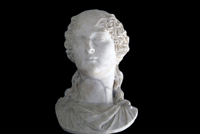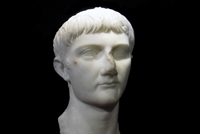HORTI LAMIANI
Lucio Elio Lamia was one of the closest friends of the Emperor Tiberius, served him as legate in Pannonia (Hungary) and Dalmatia in the years 13-15, and then as proconsul in Africa. The same Tiberius appointed him governor of Syria in 21, but the emperor, surrounded by sycophants and, worse still, under attack by dark plots, hatched mainly by Agrippina the elder, widow of Germanicus, adopted son of Tiberius himself, not wanting to deprive of the comfort of his friend kept him nearby, to appoint finally Praefectus Urbis (prefect of Rome), a position that Lamia exerted from 32 until his death in 33.
 |
 |
 |
Tiberius - Museo Nazionale |
Agrippina the Elder - Capitolini Museums |
Germanicus - Museo Nazionale |
Lamia was also a friend of Horace and given that this one belonged to the circle of Maecenas is reasonable to conjecture that Lamia was a friend of the same Maecenas. This would explain the contiguity of the Horti Lamiani with those Mecenatiani.
Lamia bequeathed his Horti to Tiberius, who, however, to escape the Roman conspiracies had retired to the isle of Capri.
Gaius Caesar better known as Caligula, son of Agrippina the Elder and adopted by Tiberius lived in Horti Lamiani, which also continued to shine at least until the time of the Severian dynasty, that is, until the beginning of the third century.
The Horti occupied roughly the area from the current Piazza Vittorio (where was the villa Palombara), to Piazza Dante.
In the devastation of the late nineteenth century all the buildings in this area were demolished, including the Villa Palombara. Those are the only remains, but from the foundations surfaced the impressive remains of the Horti Lamiani.
The priceless archeologist Rodolfo Lanciani, to whom we owe the discovery and rescue of the finds, so, in 1875, describes that incredible moment:
“I saw a gallery of 79 meters in length, where the floor was made up of the most rare and expensive varieties of alabaster (which was told Palombara from the name of the villa) and the ceiling supported by twenty fluted columns of yellow antique, resting on golden bases; I saw another room, paved with slabs of peacock eye, whose walls were covered with slabs of black slate, decorated by graceful arabesques executed in gold leaf; I have seen finally a third room, where the floor was composed of segments of alabaster, framed by green glass paste. In the walls of it were all around various jets of water a meter away from each other, which had to cross in various ways with extraordinary effect of light”.
Saved by Lanciani the finds, everything else was destroyed.
In the halls of the Capitoline Museums dedicated to Horti Lamiani in display there are some of the masterpieces saved by Lanciani, beginning with the wonderful the Esquiline Venus.
The date of birth of this Venus is under discussion, according to someone would be half of the first century BC and would not be Venus but Cleopatra. To support this claim, please note that Cleopatra was in Rome from 46 to 44 BC. Of course, Cleopatra has a great appeal, but it seems more likely that the sculpture is of the first century AD.
In any case, to note that Venus is not idealized, but is caught with a touch of realism typical of the Roman art, which manifests itself in the right hand that collects hair
, in sandals with thongs and in the guise resting on the pedestal, where is a coiled snake, symbol of the hidden dangers.
Just beyond her we see Commodus, with two tritons aside, portrayed as Hercules; at the base we see an Amazon, the other was lost.
Commodus, son of Marcus Aurelius, was assassinated in 192 and, moreover, the Roman Senate condemned him to "Damnatio Memoriae", punishment involving the destruction of any trace of his existence. But who at the time lived in the Horti Lamiani thought it well to hide his Commodus and a few years after Septimius Severus, the new emperor, canceled the Damnatio Memoriae and decreed the apotheosis of Commodus therefore his deification, just to make it clear to the Roman senate who commanded.
Even in this environment can't miss Dionysus, and the Centaur, incisive Roman replica of an original of the Hellenistic middle period, the one characterized by the dramatization of the expressions.
In the next room you see the extraordinary movement of the group of two girls playing, a rare original Greek of the fourth century BC.
In the contiguous interior is placed a stretch of about ten meters of the alabaster floor described by Rodolfo Lanciani; in this same interior we see the capitals pilasters (ornamental pillars), carved on an antique red marble base, and gems that decorated the wooden walls of the rooms of the villa.
Trunks of alabaster columns let us imagine the splendor of the environments.
Going from the Conservatori Palace to Nuovo Palace, yet inside the Capitolini Museums, in the great hall stands the magnificent Apollo chitarist, replica of an original of the late Hellenistic age.
Left the Capitolini Museums and the Capitol too, we can continue the visit to the Horti Lamiani going in Ostiense street to Montemartini Museum, previously a power plant, which is part of the Capitoline Museums.
Apart from our Horti a visit to Central is highly recommended both for the spectacular staging and the masterpieces exhibited.
Here, among others, we see some findings of Lamiani of exceptional interest, starting with the portrait of young man which preserves traces of the ancient colors and gilding, as the beautiful male head.
Finally, do not miss the trunk of Athena Parthenos, roman replica of the statue of gold and ivory that Phidias had placed on the Parthenon in Athens.
To crown our trip in Horti Lamiani we just have to get to the impressive and unforgettable “Museo Nazionale Romano” (=National Roman Museum), where is exposed a relief with Maenad, of particular interest because it suggests that in the rooms of the villa were to be many other reliefs, probably destroyed in the Middle Ages and reused as building materials. Finally look at the magnificent Discobolus Lancellotti perfectly preserved, replica of one of the most admired masterpieces in antiquity: the bronze discobolus of Myron. Lost.
back |

